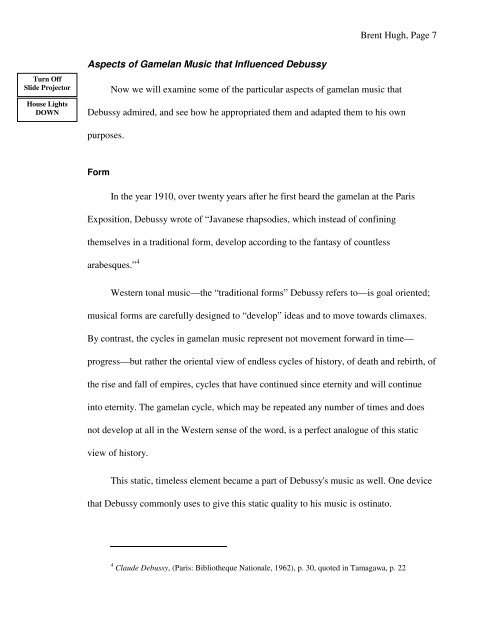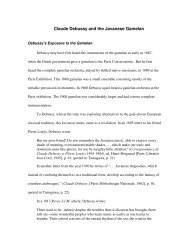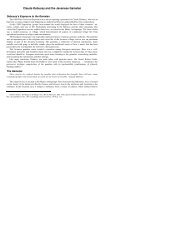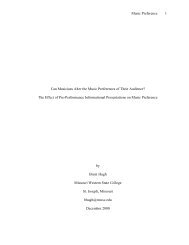Claude Debussy and the Javanese Gamelan
Claude Debussy and the Javanese Gamelan
Claude Debussy and the Javanese Gamelan
You also want an ePaper? Increase the reach of your titles
YUMPU automatically turns print PDFs into web optimized ePapers that Google loves.
Turn Off<br />
Slide Projector<br />
House Lights<br />
DOWN<br />
Aspects of <strong>Gamelan</strong> Music that Influenced <strong>Debussy</strong><br />
Brent Hugh, Page 7<br />
Now we will examine some of <strong>the</strong> particular aspects of gamelan music that<br />
<strong>Debussy</strong> admired, <strong>and</strong> see how he appropriated <strong>the</strong>m <strong>and</strong> adapted <strong>the</strong>m to his own<br />
purposes.<br />
Form<br />
In <strong>the</strong> year 1910, over twenty years after he first heard <strong>the</strong> gamelan at <strong>the</strong> Paris<br />
Exposition, <strong>Debussy</strong> wrote of “<strong>Javanese</strong> rhapsodies, which instead of confining<br />
<strong>the</strong>mselves in a traditional form, develop according to <strong>the</strong> fantasy of countless<br />
arabesques.” 4<br />
Western tonal music—<strong>the</strong> “traditional forms” <strong>Debussy</strong> refers to—is goal oriented;<br />
musical forms are carefully designed to “develop” ideas <strong>and</strong> to move towards climaxes.<br />
By contrast, <strong>the</strong> cycles in gamelan music represent not movement forward in time—<br />
progress—but ra<strong>the</strong>r <strong>the</strong> oriental view of endless cycles of history, of death <strong>and</strong> rebirth, of<br />
<strong>the</strong> rise <strong>and</strong> fall of empires, cycles that have continued since eternity <strong>and</strong> will continue<br />
into eternity. The gamelan cycle, which may be repeated any number of times <strong>and</strong> does<br />
not develop at all in <strong>the</strong> Western sense of <strong>the</strong> word, is a perfect analogue of this static<br />
view of history.<br />
This static, timeless element became a part of <strong>Debussy</strong>'s music as well. One device<br />
that <strong>Debussy</strong> commonly uses to give this static quality to his music is ostinato.<br />
4 <strong>Claude</strong> <strong>Debussy</strong>, (Paris: Biblio<strong>the</strong>que Nationale, 1962), p. 30, quoted in Tamagawa, p. 22





